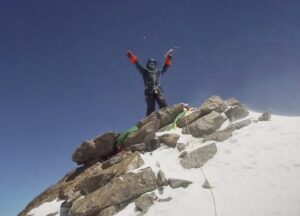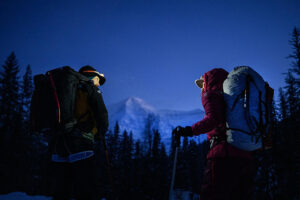Audentes fortuna iuvat, the ancient Romans used to say — fortune favors the bold. Rarely has this motto proven more true than when the goddess spread her long fingers and touched three young British climbers on a faraway peak rising from the lonely Tibetan plateau.
Shishapangma is quite humble for an 8,000’er. It’s the smallest of the 14 and its name is not mythological, but rather descriptive. It means, “the range above the grassy plains”. It also carries the tag of being the easiest of the 8,000’ers and is not as deadly as its mates. Moreover, it can be comfortably approached by a paved road that ends a few hours from Base Camp. If it’s not attracting crowds every (normal) year, that’s only because it lies completely in Tibetan (therefore Chinese) territory, and permits are always scarce and messy to obtain.
Moreover, the normal route on the north side leads to the sharp summit ridge, far from the actual highest point, which is the eastern summit. On the way, two secondary summits tempt climbers to get a cool summit shot and spare the pain of traversing the ridge beyond the western and Central summits. The latter is 8,008m and is, actually, the farthest point reached by many climbing teams and the source of many heated controversies.
However, the easy one has an “alpine side”. Looking southwest and three days away from the roads rises an elegant, 2,500m face combining mixed terrain and a series of ice and snow couloirs. Although it’s visible in the distance from Nepal’s Langtang Valley, the first team that climbed it had never glimpsed it before. And yet, they came, saw, and succeeded on a remarkable climb.
Things were both different and not so different back in 1982. On the one hand, the massif was little known — exploratory terrain. On the other hand, getting into Tibet was the same bureaucratic nightmare that it is today.

Alex MacIntyre was 28 when he climbed Shishapangma. Sadly, he perished months later on the south face of Annapurna. Photo: Desnivel
Nick Prescott first asked for a climbing permit in 1979, which was granted two years later. By then, his original team had disbanded, and Doug Scott took over the permit and the leadership of a group that included Roger Baxter-Jones, Alex Maclntyre, Prescott, and himself. Elaine Brook joined the team for the acclimatization phase only, and Prescott acted as BC manager. A seventh member, Paul Braithwaite, got ill shortly after departing Lhasa and returned home without climbing.
The first hardships arose even before they set foot in Tibet, due to the effort required to raise the necessary funds: Climbing in Tibet was then five times more expensive than in Nepal. They had to confirm their permits, survive paperwork, and engage in endless red tape with the China Mountaineering Association in Lhasa to sort out the final logistical details.
They reached the area at the end of April and spent most of May acclimatizing on nearby peaks, which were tall enough to deserve an expedition of their own. They climbed the South Ridge of Nyanang Ri (7,010m) without summiting and completed the first ascent of Pungpa Ri (7,445m). According to Scott, Pungpa Ri “is really the SW shoulder of Shishapangma about one mile away and separated from its parent summit by a saddle at 24,000 ft [7,315m].”
This facilitated logistics because they could set up a single Base Camp for both Pungpa Ri and Shishapangma Main. They called it Castle Camp.
Their acclimatization protocol became the standard strategy for future alpine-style Himalayan ascents and their new routes and first ascents added extra value to the expedition. On the other hand, they would virtually on-sight their main target in a single push from top to bottom.
The five previous ascents of Shishapangma had all proceeded in traditional expedition style, with climbers rotating progressively up and down, fixing the route as they went. Scott’s strategy, however, was a rather radical way to get used to altitude: They completed their two “rehearsal” climbs on single, lightweight pushes from the base to the 7,000m+ summits.
After four days of rest after Pungpa Ri, the team started toward their main goal. As Scott said, they had at least opened a route that could serve as a possible descent route from the main summit, although they “had not seen the way up in detail.”
Not that they had a problem with that. On May 25, Scott, Baxter-Jones, Maclntyre, and Prescott crossed the exposed icefall to the base of the SW face and simply started up. And goddess Fortuna kept smiling upon them.

Alex MacIntyre on his way back from the main summit, on the ridge to the Central Summit of Shishapangma, May28, 1982.
The three-man team (Prescott retired to BC after the first day) found good snow and a clear route up the face, with the steeper sections less vertical than they had expected. Never retreating, they made three bivouacs on the way up and one more while descending. Their swift progress up the 2,500m face owes mainly to the fact that they climbed mostly unroped until the upper sections.
Once on the summit ridge, they made sure they continued to the highest, eastern point which, as Scott pointed out, “may or may not have been visited before.” Then they traversed the whole ridge until they reached the route they had used for Pungpa Ri and went down that way. Feeling confident in familiar terrain, they used no rope to descend down 45º to 55º couloirs back to the glacier and to Castle Camp.

Doug Scott unroped on the route.
From a strict sense of difficulty, this British route up Shishapangma’s South Face is not as hard as other lines in this “best of” series, such as Annapurna South Face or Kurtyka’s ascent of GIV’s Shining Wall. In fact, future teams opened harder routes on that same face. But that’s the point: “future”. The present team laid the groundwork for what was to come.
The real value of the feat achieved by Maclntyre, Scott, and Baxter-Jones lay in the visionary ingenuity to venture to a far corner of the world on an adventurous journey to a semi-closed country and attempt in impeccable style a huge mountain face that they had not seen before — neither renouncing their climbing principles nor using altitude, uncertainty, or acclimatization needs as excuses.
Eventually, they completed the route flawlessly and reached the real summit of a mountain with many confusing sub-peaks. Then they made it back down, unharmed and utterly happy. As Scott put it: “One of the most satisfying we had done in the Himalaya — a classic line up varied terrain on a major face, isolated and unexplored.”

Future lines up the South Face of Shishapangma were done alpine style, a a tribute to that first visionary ascent.
It was also one of those classic climbs that filled a generation with climbing dreams: the members’ memories and diary notes, including their arguments and differences of opinion, were turned into a book by Scott and MacIntyre. It won the first Boardman Tasker Prize for Mountain Literature.
The first ascent of the South Face of Shishapangma not only shone brightly as a paradigm of alpine style, but was a game-changer that proved that climbing excellence could be translated from the Alps to the Himalaya, as long as the team was skilled, strong, creative, and daring enough.

Doug Scott.
And their climb of this so-called easiest 8,000’er, Shishapangma, set the standard for future lines on its elegant face. All subsequent routes were opened in more or less alpine style. Anyone eyeing Shisha’s South Face recognized the unwritten rule that you either went in style or faced the disdain of the climbing community. No wonder that in subsequent years, the Face hosted some of the best climbers in the world and became the scene for three remarkable solo ascents, by Krzysztof Wielicki, Jean-Christophe Lafaille, and Ueli Steck.
Finally, this also pays further tribute to the late Doug Scott. His article in the Himalayan journal, which was one of the key sources for this piece, reveals his approach to mountaineering: factual, with no ornaments or unnecessary melodrama, just pure and absolutely excellence-oriented. He will be sorely missed by those who ever met him and by the many who admired his career and his lines on beautiful mountains.

A Korean climber above his camp on a later repetition of the British route. Photo: Cristina Pogacean






